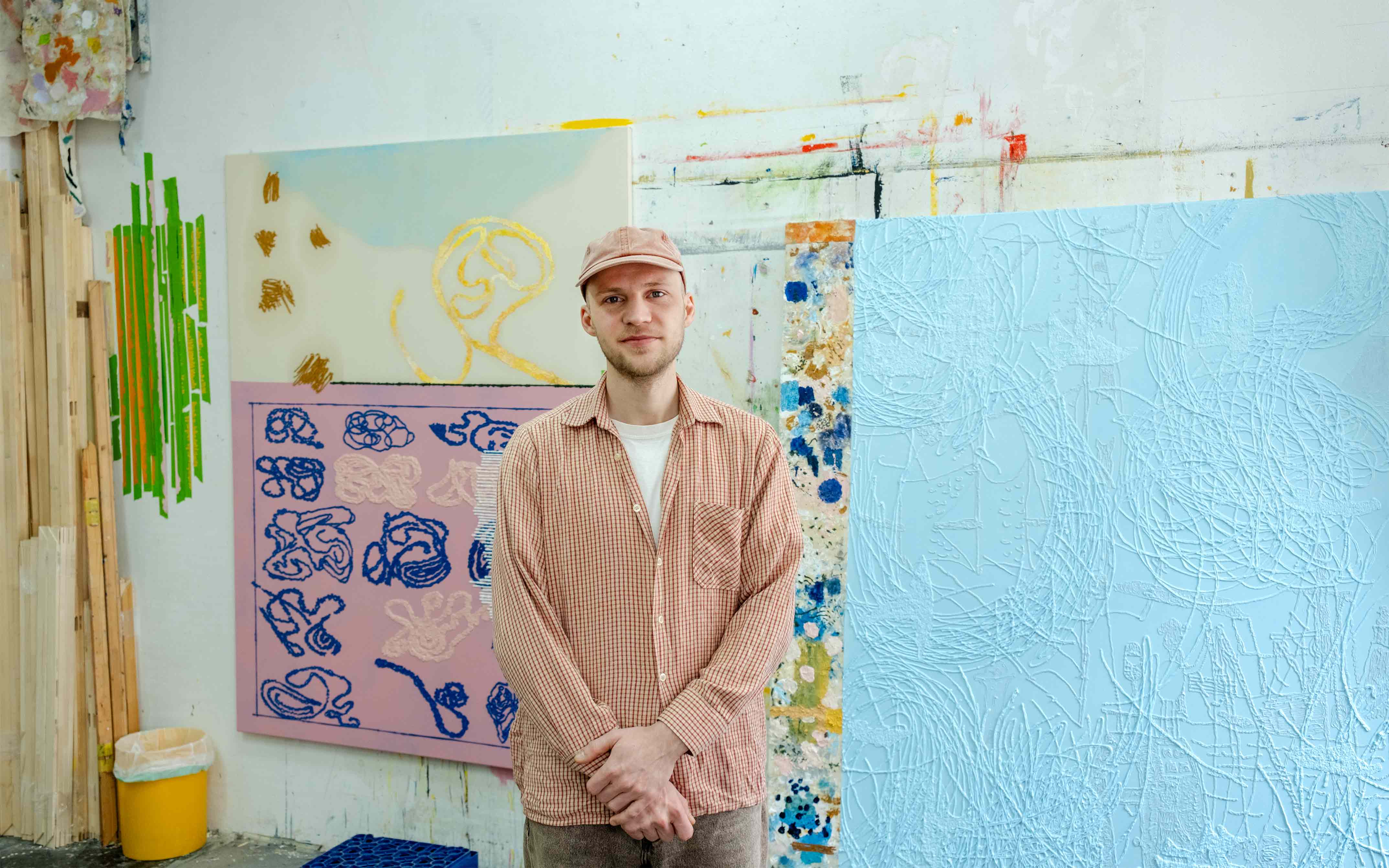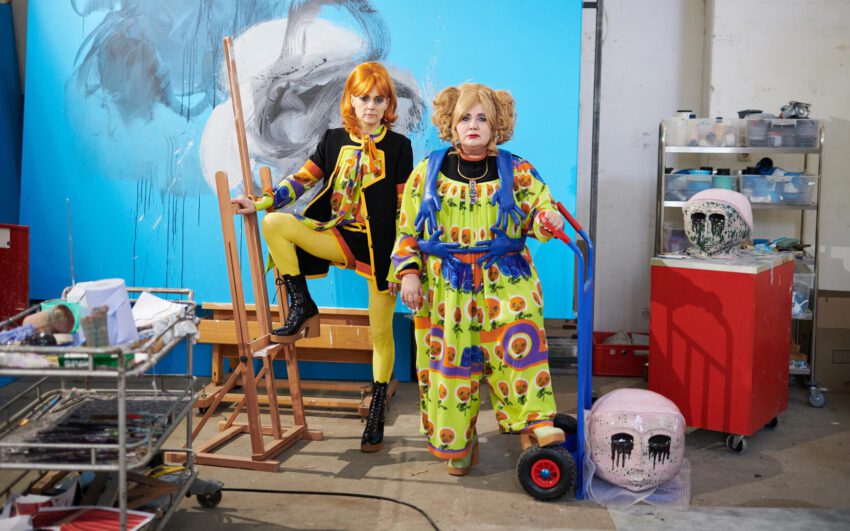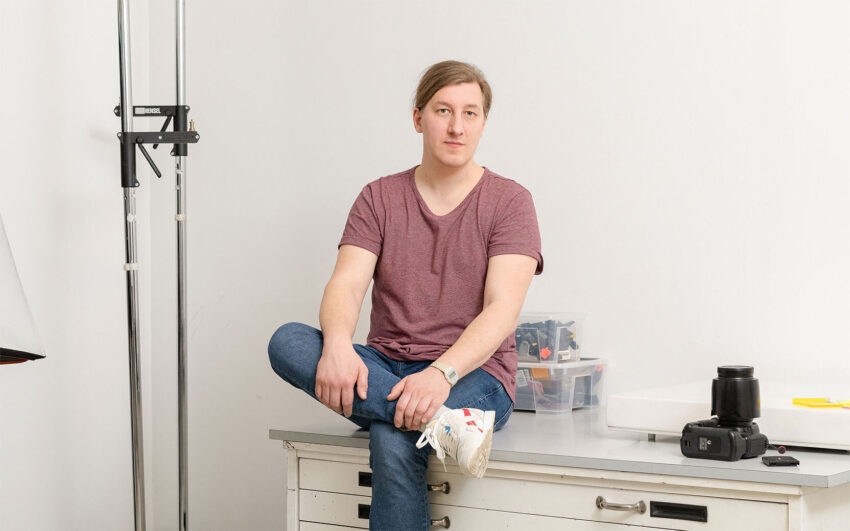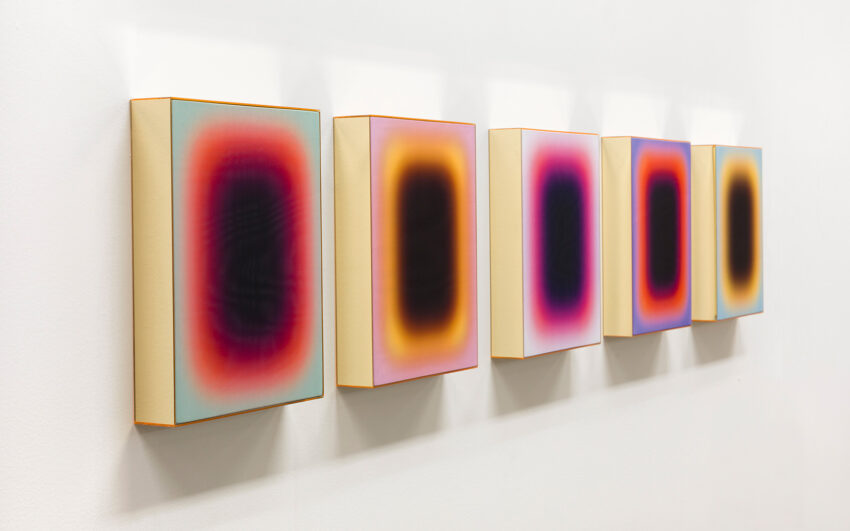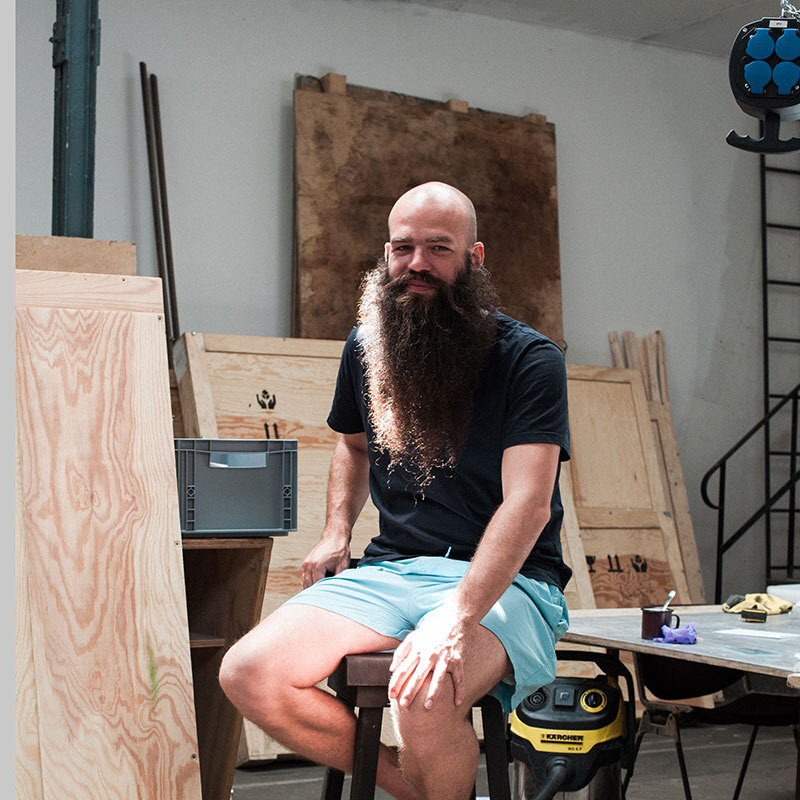Max Freund is not satisfied with just one way of expression: he draws, paints, sews and collages. At the same time, he runs a publishing house together with friends, in which his interest for graphic print comes to show. In his work, figurative painting meets abstract shapes, and both are equally important to him. His inspirations come from music and literature, as he translates their rhythms into art.
How did you become an artist?
In an almost cliché way: as a child, I loved drawing and using all kinds of materials, including the walls at home. My parents actually never painted over my scribblings in the entrance! However, even though drawing and painting were always of interest to me, I only realized quite late that it could be a profession. After my A-levels I went to the Academy of Fine Arts in Vienna. And I understood that there is not one linear way into art, regardless of whether you study or not, or make it your job. To me, the experimentation and the switching between different media still is the driving force behind my work.
Therefore, one does not become an artist because, but nevertheless?
True!
What was your experience during your studies?
I felt very free! I studied in the painting class of Judith Eisler. I could try out so many things at Uni, ceramic, print, sculpture, letterpress, and works in the public space. Later, I got into graphic print and books. Today, I publish books in small editions: it is a nice link between the world of painting and drawing. The publishing house is called SOYBOT and concentrates on risograph print. It is a common project with friends, which we run besides our jobs.
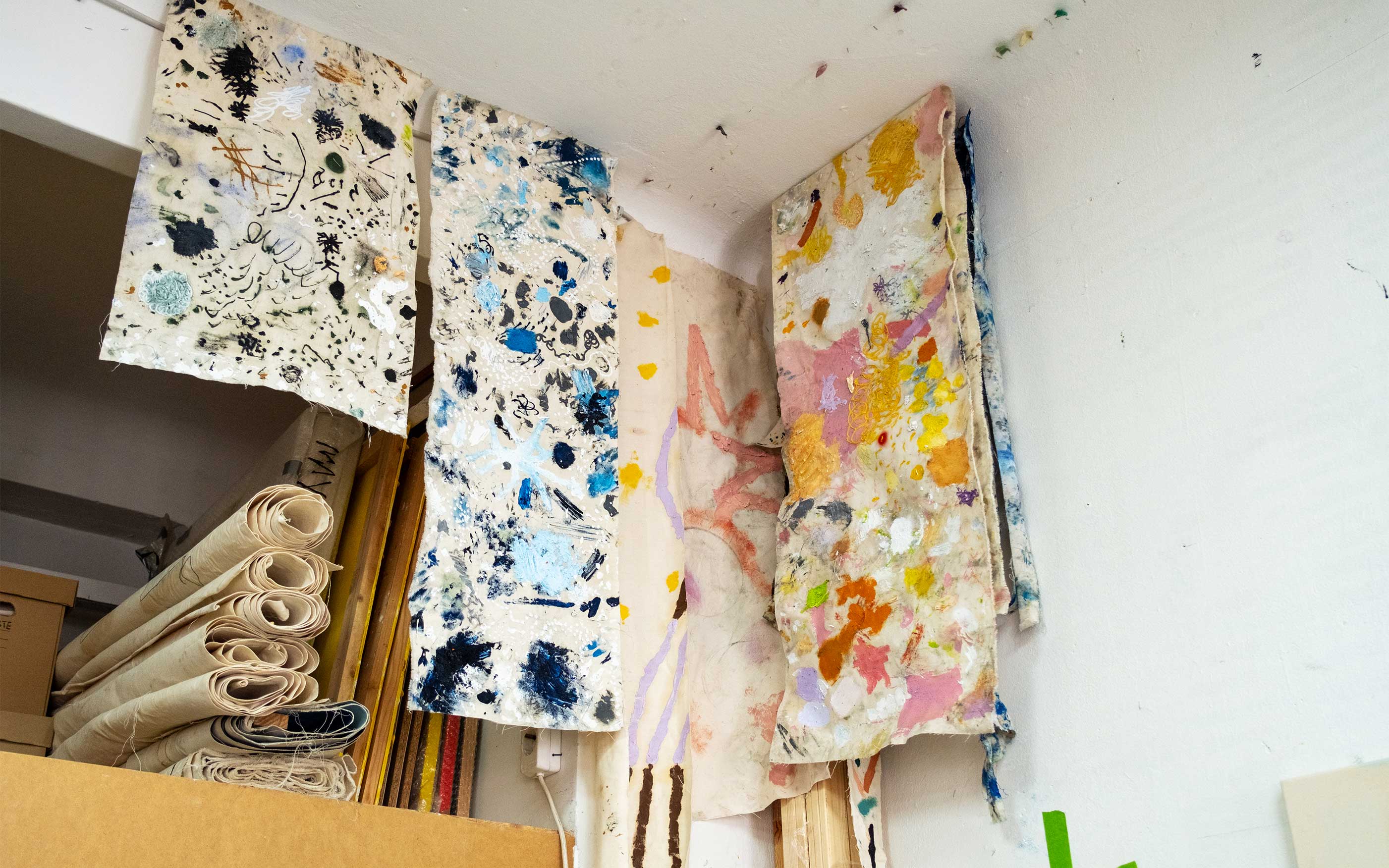
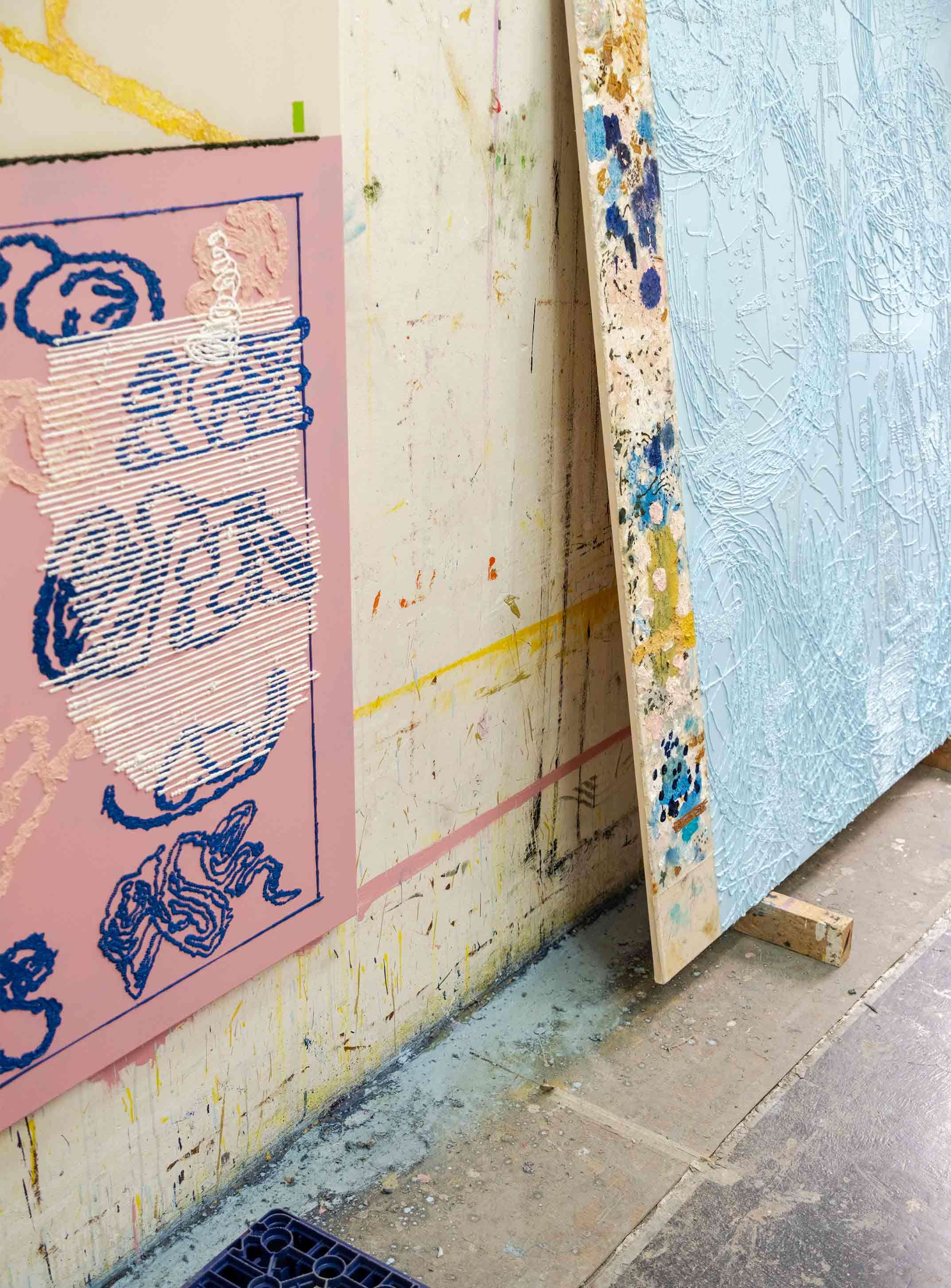
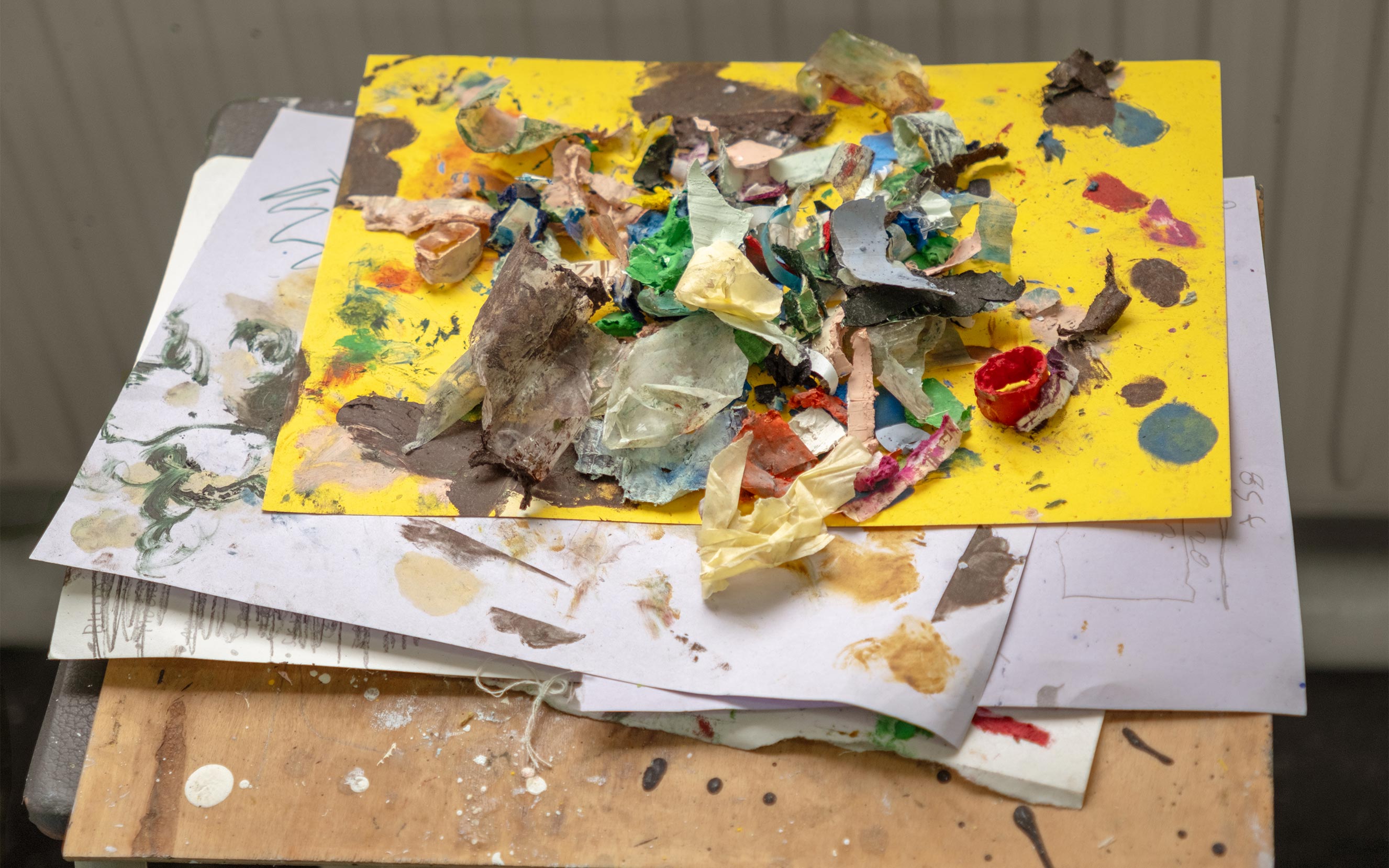
What is the common thread that runs through your work?
Definitely the drawing: everything originates there. I like to translate lines or graphic elements into painting, to alienate them. Painting works at a different speed. It can transform lines into surfaces and can easily play with colour, texture and size. And time is important to me, holding on to time. This is one of the most beautiful things that can happen in painting. Creating moments also works perfectly in music and literature; to halt time and open imaginary spaces to expand our reality.
Because it captures the moments during which you have worked on a painting?
Not only that. It is also about the state of our times as a society. The image, no matter what form it takes, is like a time capsule — it can send you into different eras through memories and references. I think found or previously belabored textiles help with this, which is why I like including them in my work. The drawing happens very quickly, but painting is a much more time-consuming process with different challenges and therefore comes in a different tense.
Are you sketching your paintings first?
It depends. I might use some motives from my drawings. But it is more about how I want to translate an idea: through a book, painting, fabrics… This is how I can choose the texture. And I like it if my pictures look as if they were done quickly and spontaneously. However, when you come close, you can see all the different processes it took me to get there; there are hidden information, painterly decisions and detours. It is very appealing to work with the haptics of materials that show how fragile our surroundings and emotions are.
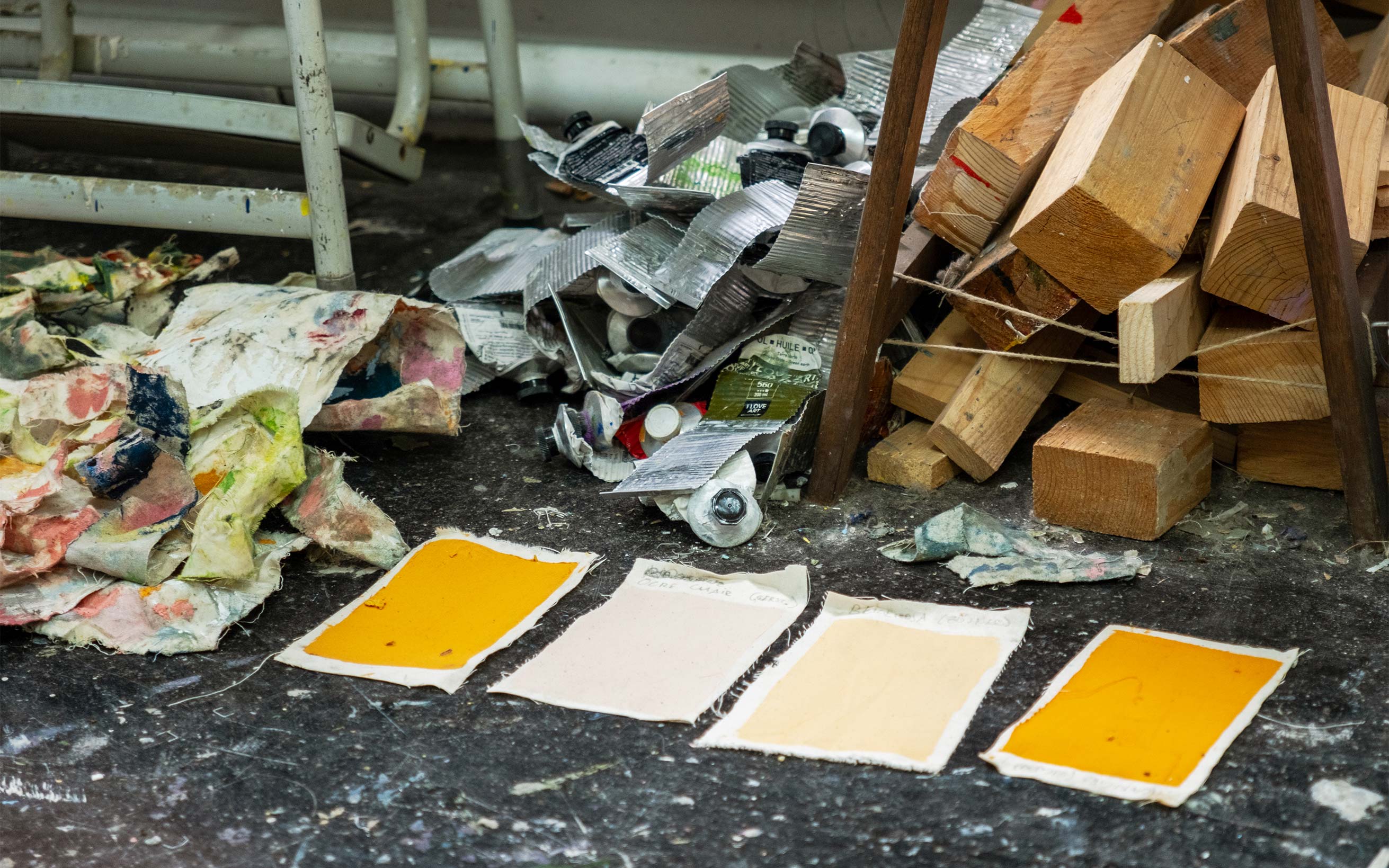
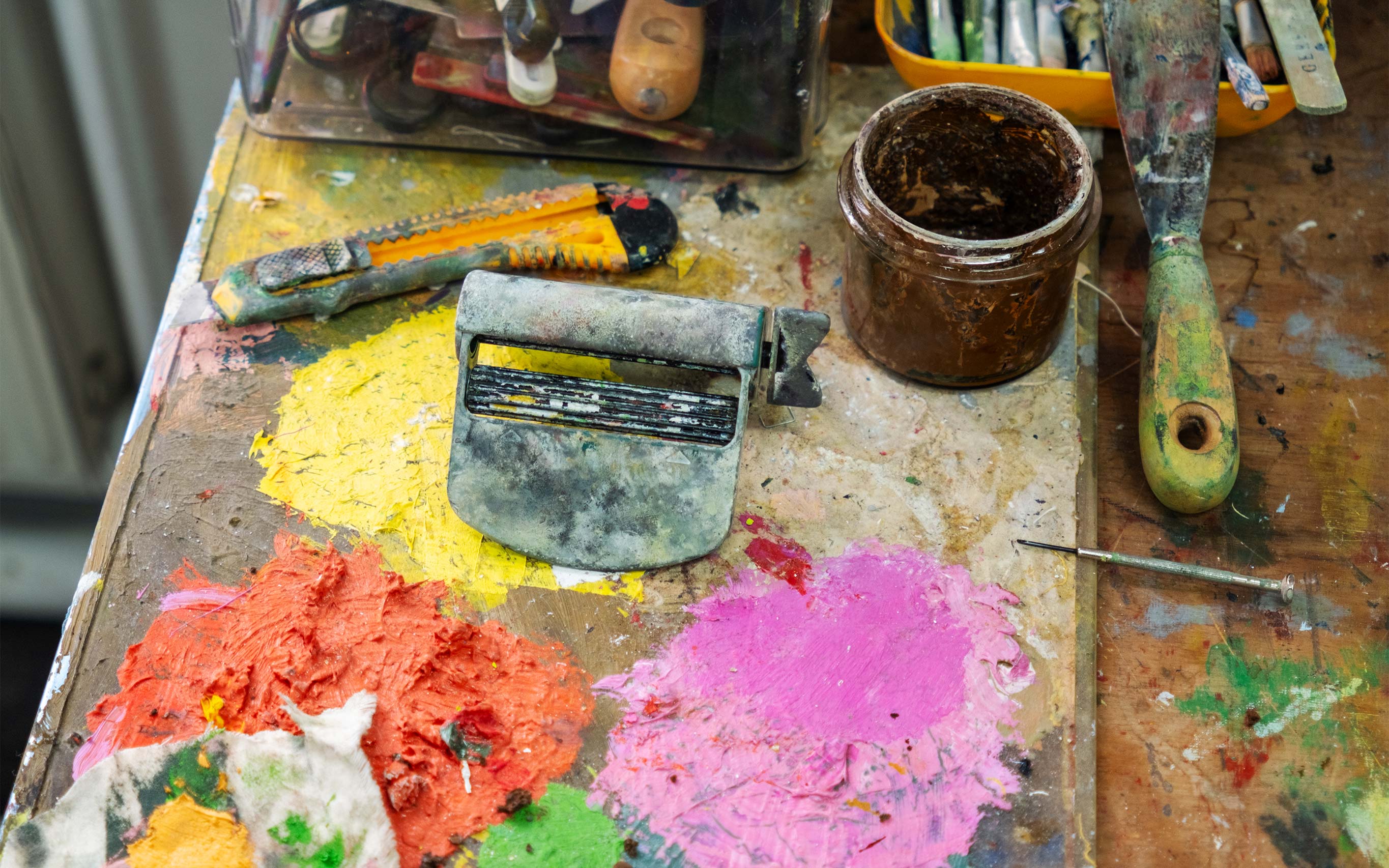
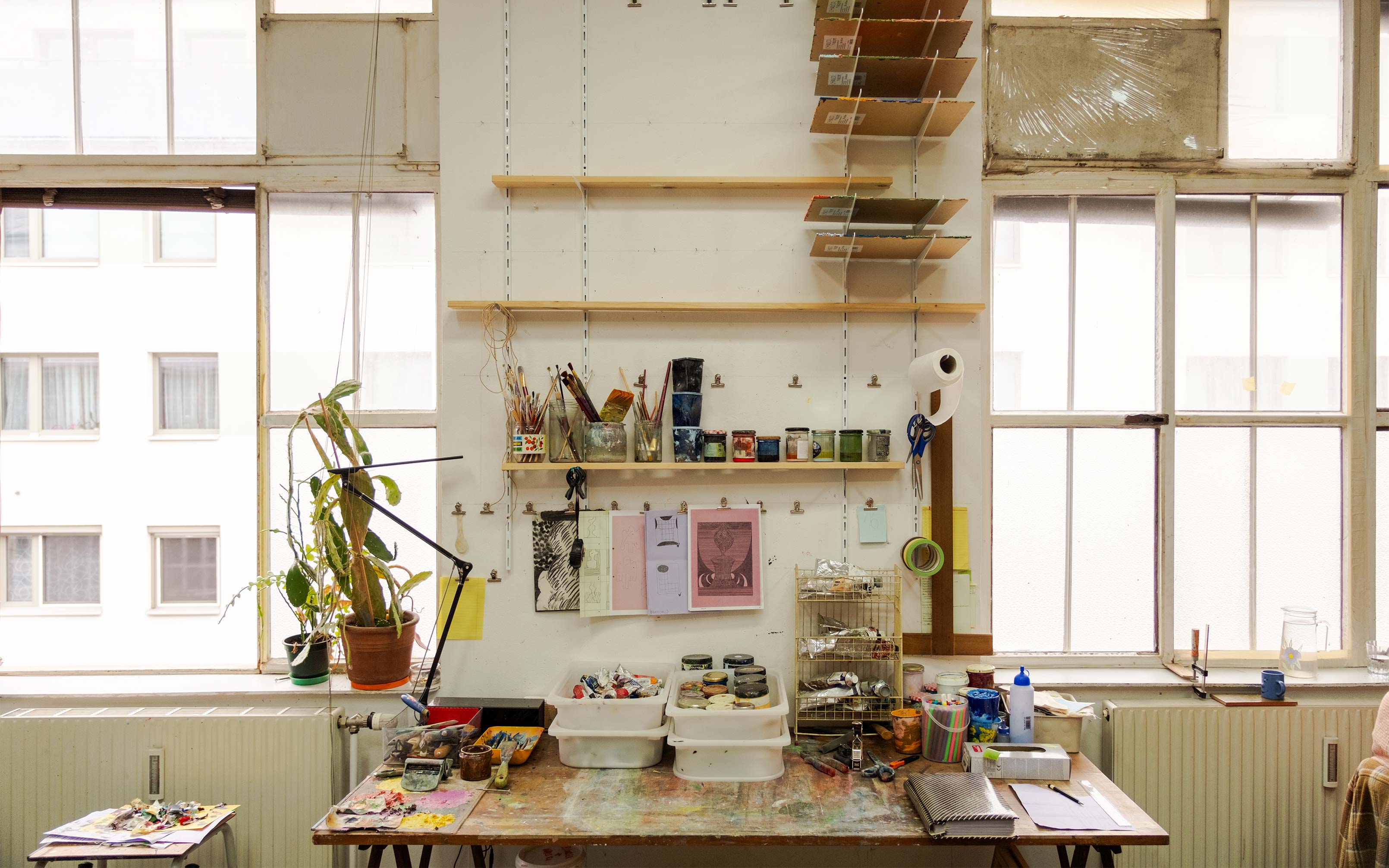
Abstract and figurative painting consequently happen at the same time?
Yes, mostly. Sometimes I might concentrate more on an object or a fragment, and sometimes I might mix up both. According to my interest in the shapes and colours I decide whether I want to zoom into a certain detail. I would not like to relinquish figuration for abstraction, or the other way round. I think that a fusion should be taking place. And even if to me it is more of an abstract painting, there must always be a small space for a figure left.
Next to drawings and paintings, you also execute textile works. What do you call these?
Probably still painting, even though I work with the means of a collage. In my studio, I have created an ecosystem. There is a place where I keep old, cut-out pictures, another where there are rags on which I dry my brushes, and another where I store notes or drawings which I created along the way. This is a constantly evolving archive and pool which I can come back to anytime. All this adds up to a pattern and allows me to mix up old and new, like a remix. For instance, in this blue painting on the wall over there, the fabric strip on the left side looks like a painter’s palette… The strip was created separately, and I only later collaged it onto the canvas - as a way of marking the beginning of the painting’s story. It relocates the painting in a different context because it reveals another part of the process: its origin. And the eye instinctively picks up the colour from the strip, feeding it into the otherwise monochrome image.
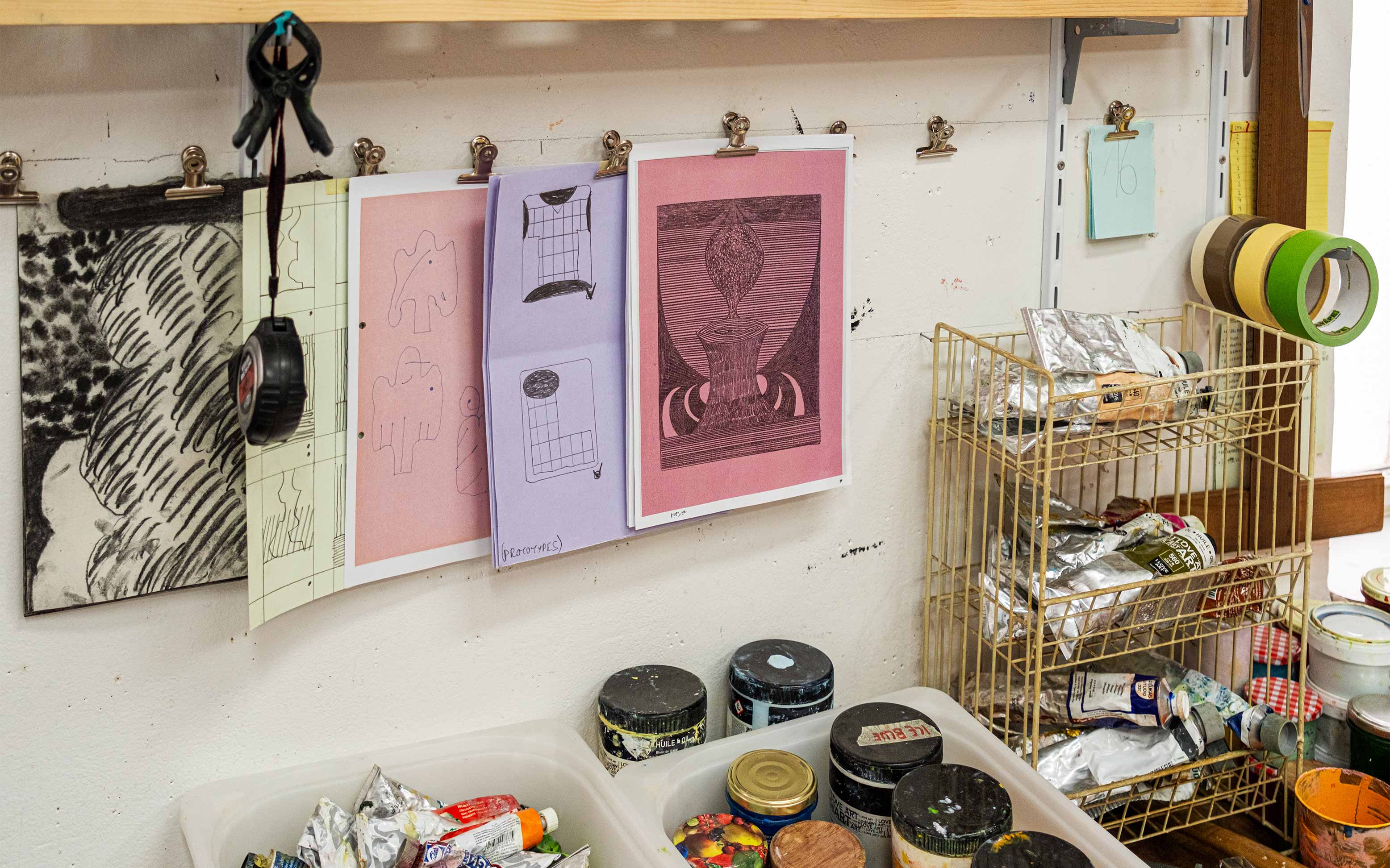
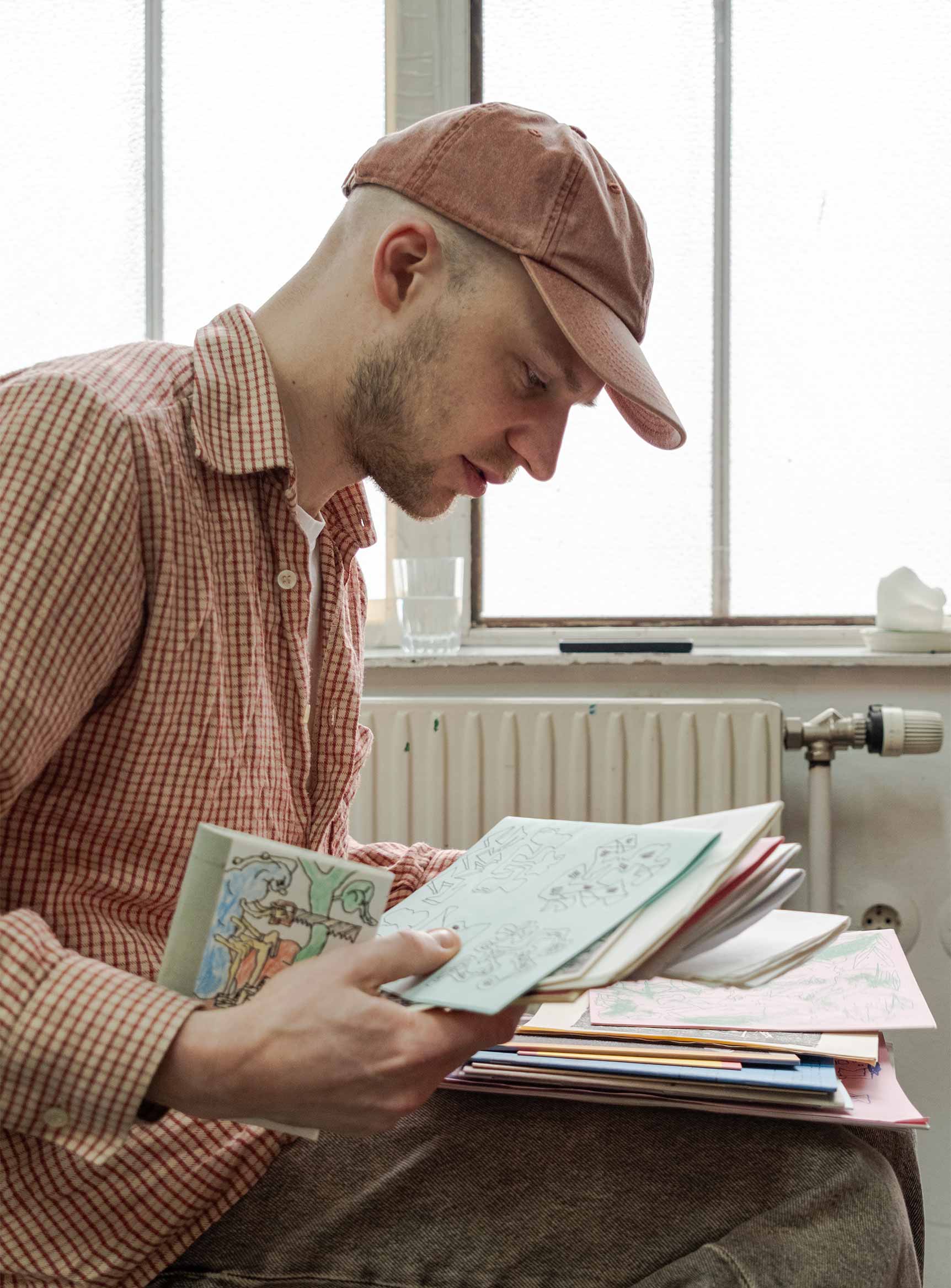
This is how you show your colour-finding?
Yes exactly. This strip is like an index, that explains how painting functions, where it starts and where it ends. And how limited it is, however much I love it.
Therefore, are your collages paintings to you?
Yes, because my thoughts are the same for any conception of a picture, be it a painting or a text montage. There are defined surfaces or dense descriptions, different perspectives and narratives. The fabrics I incorporate also draw their strength from that - from their wear, from the stories they already carry. They serve as meaningful additions to the painting, without competing with it. It's the combination that matters to me.
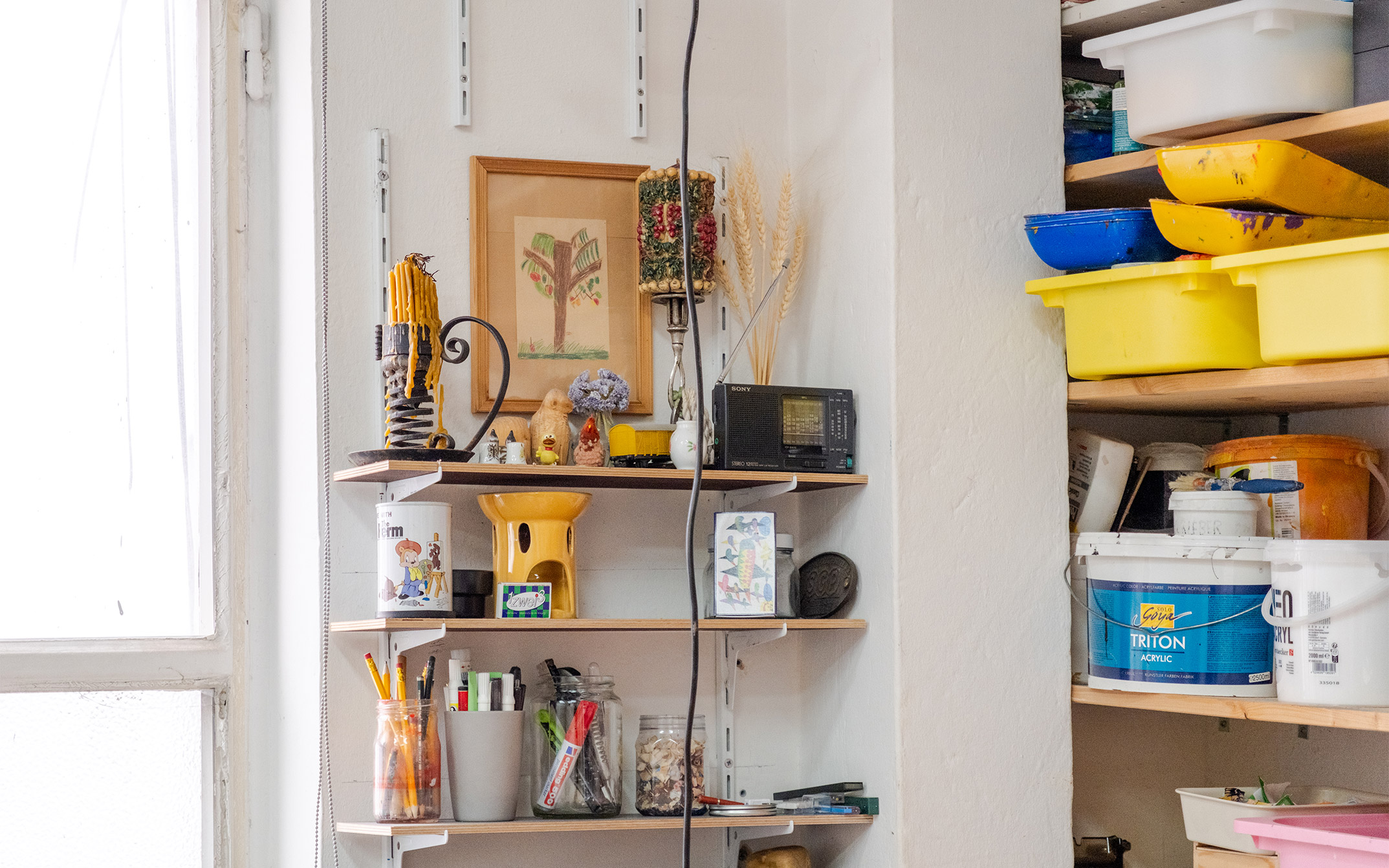
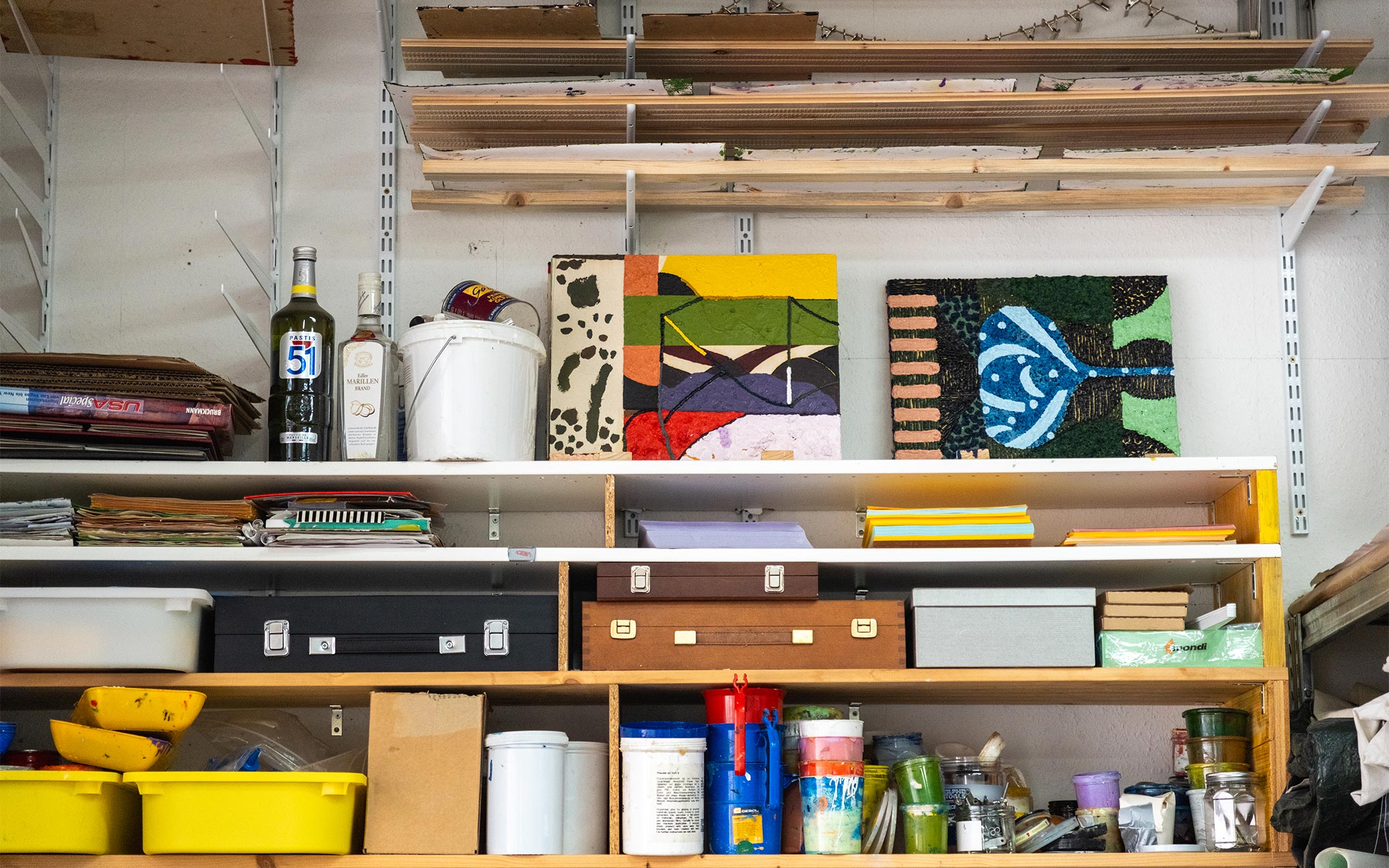
What do you think about painting today?
I think we should part with the old-fashioned conception about the often romanticized artist life and the painting. The power of painting lies in the fact that it still fundamentally shapes our perception of images. It can exist without commercial value; it comes into being regardless. It frees itself from one-dimensional labels and limitations, and within that space, something new can still emerge. Painting will always remain a companion to humanity.
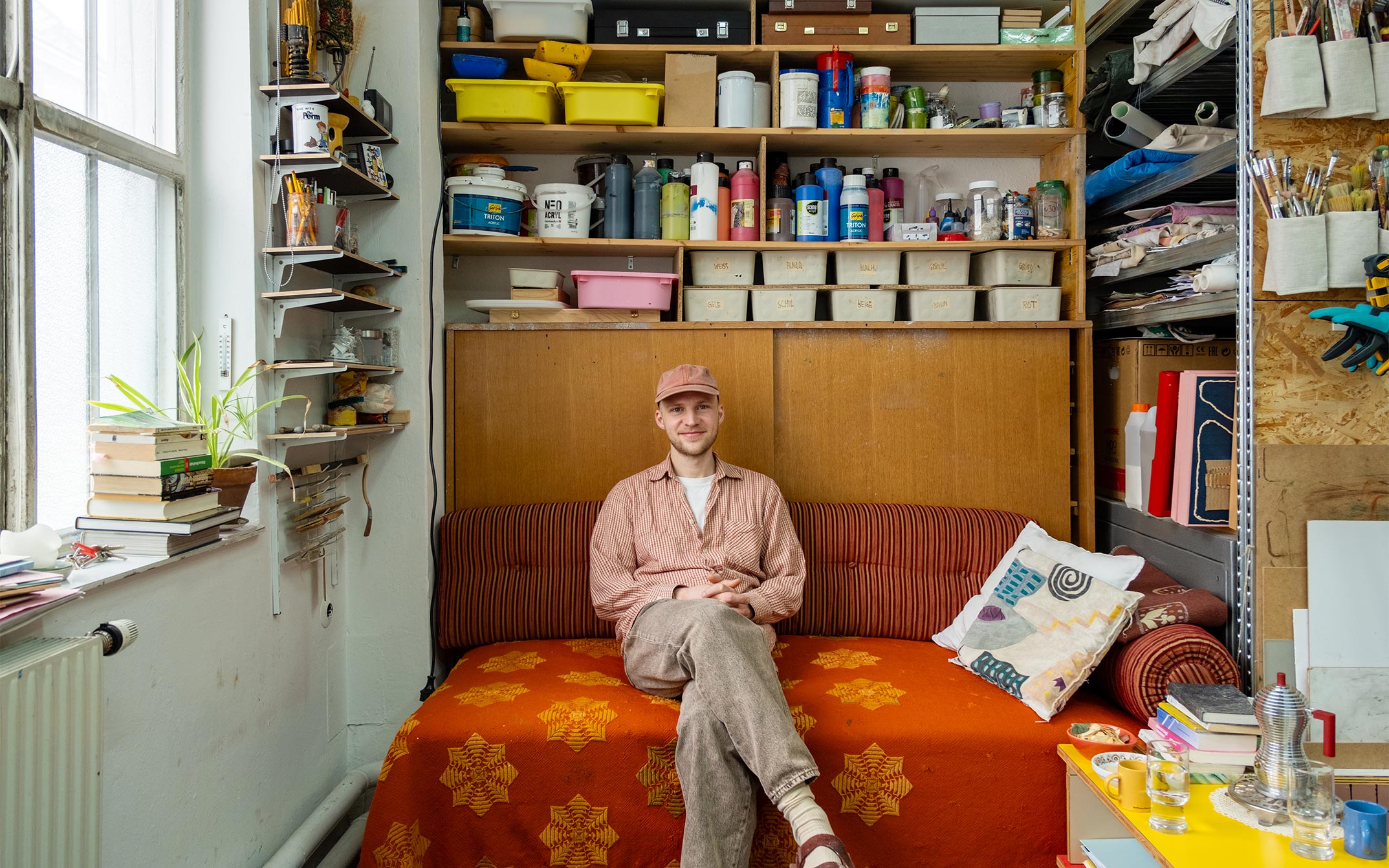
And something that endlessly fascinates people. Despite the flood of images on the internet, painting is still very much in demand…
True, because it is analogue and works so well in the present! This is why we probably still need it - and the books, and the music!
And of course, it is never satisfying to just look at pictures on a screen.
Exactly. Painting can allow for intimacy. But painting can seem detached from reality, too, because it never offers rational explanations. And this is a necessary evil. The internet might add to our perception of reality, but at the end of the day, we mustn’t fear that it will take over reality.
You have mentioned that you listen to quite a bit of music when painting. Are you constructing a work of yours like a piece of music?
I do see lots of similarities between music and painting: the sequences, the rhythm, the formal aspect… In my paintings, there are fields of tension, and they’re also about voids - both of which are just as important in music.
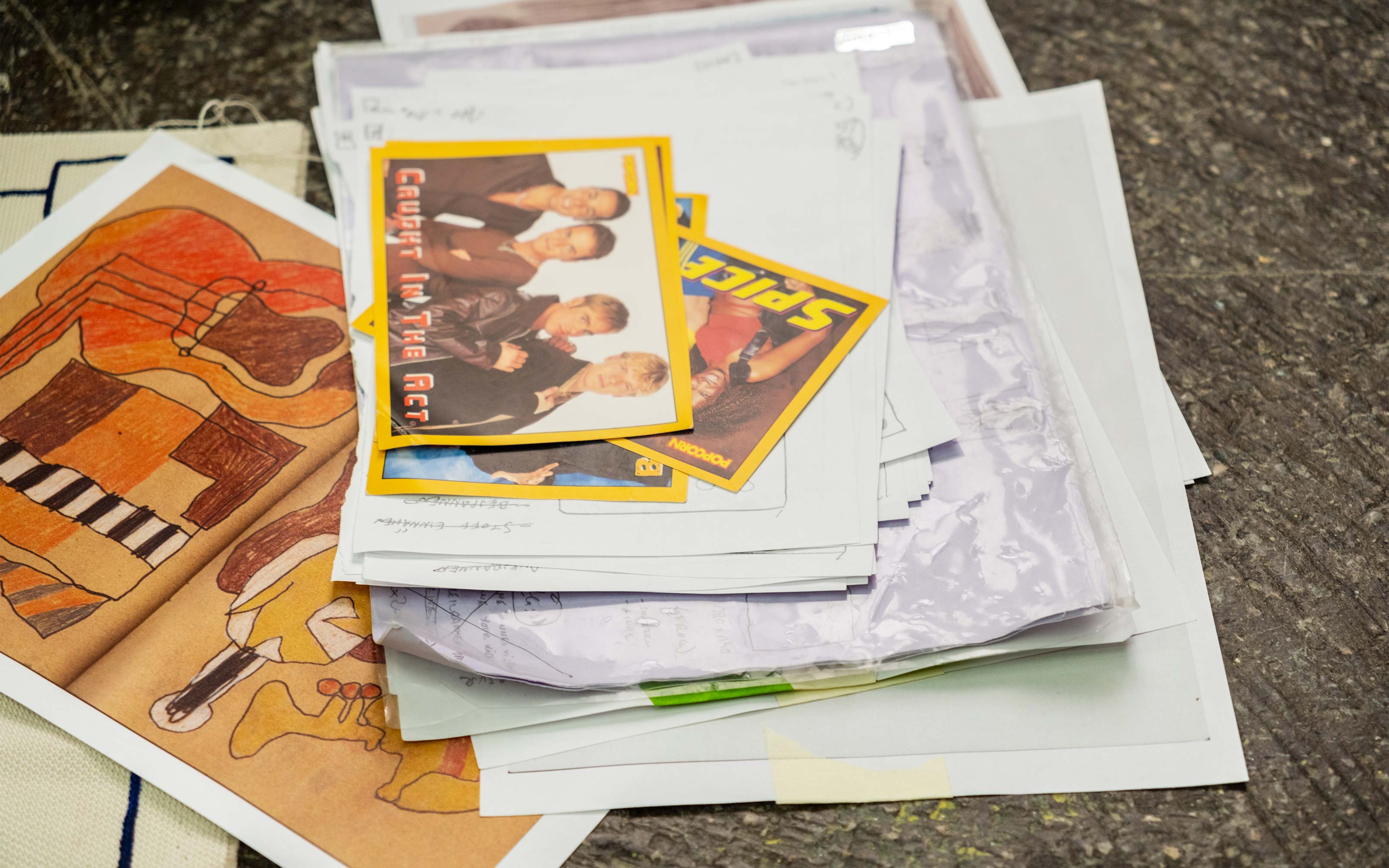
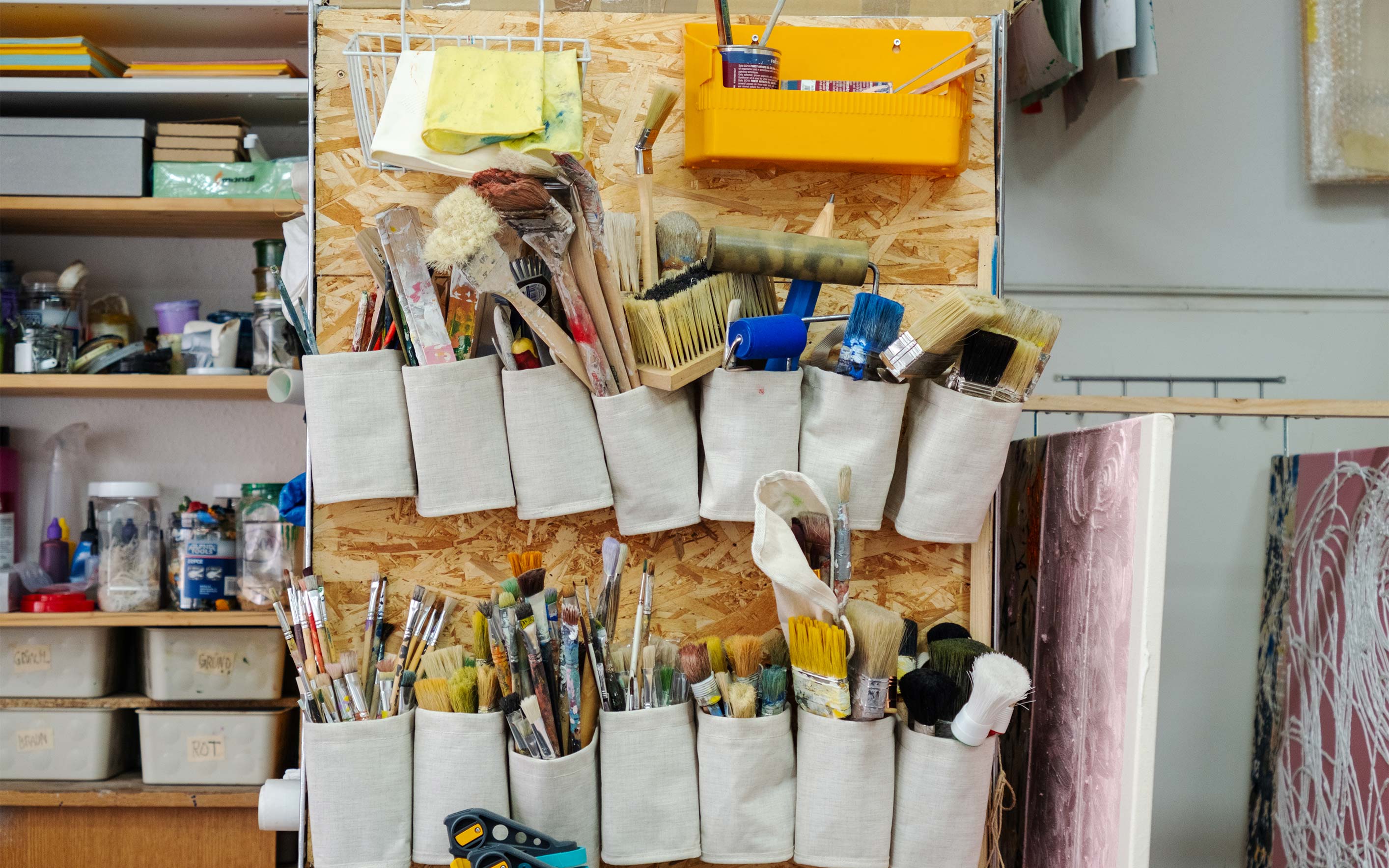
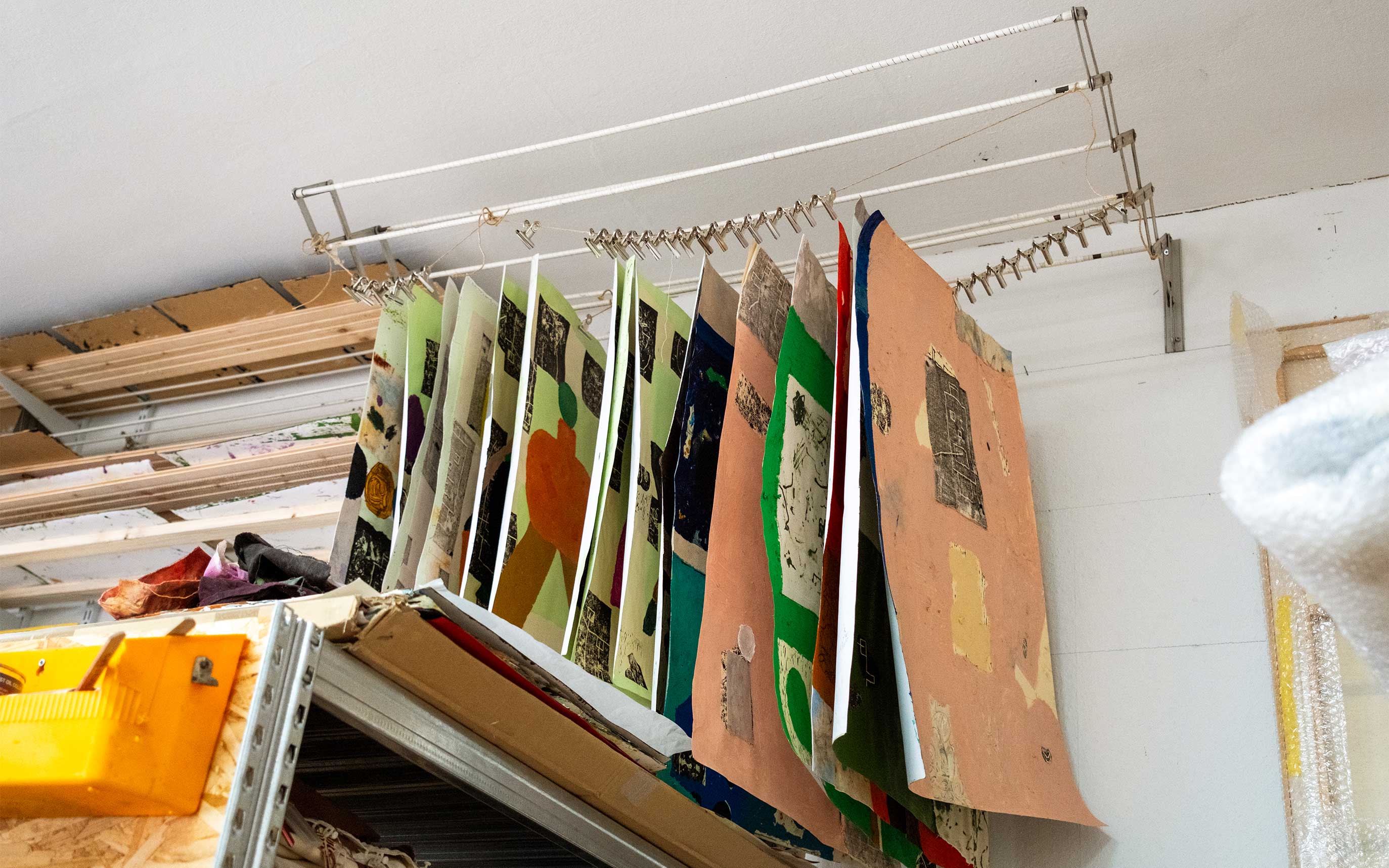
What are you listening to?
Different things, lots of radio shows at the moment, confronting one with unfamiliar music. For instance, there are broadcasts of the music producer Francesco Fusaro on NTS. There is a lot of classical music well apart from the mainstream, and they build a bridge from time to time to Breakbeat or Rap samples. It’s the same with books - they become interesting when one starts reading the ones one had not been planning to.
Rhythm is equally important in literature, right?
Right, and this is my other reference. You can find rhythm in my paintings, but also in their titles. In general, books influence my painting as much as music, because they resonate in the mind.
Your inspiration comes from music and literature. Does this mean that you would rather seek out inspiration yourself than “finding” it on the street?
Mostly. But of course, I do go out! I take photos of the diverse things I might see on the street, or I bring found objects back home. The fabrics that I collect always come from the outside world. Container, building sites, old houses, carpet shops, dumps… I just cannot walk around with my eyes closed. There is always something that will get to me and later will find a place in my painting.
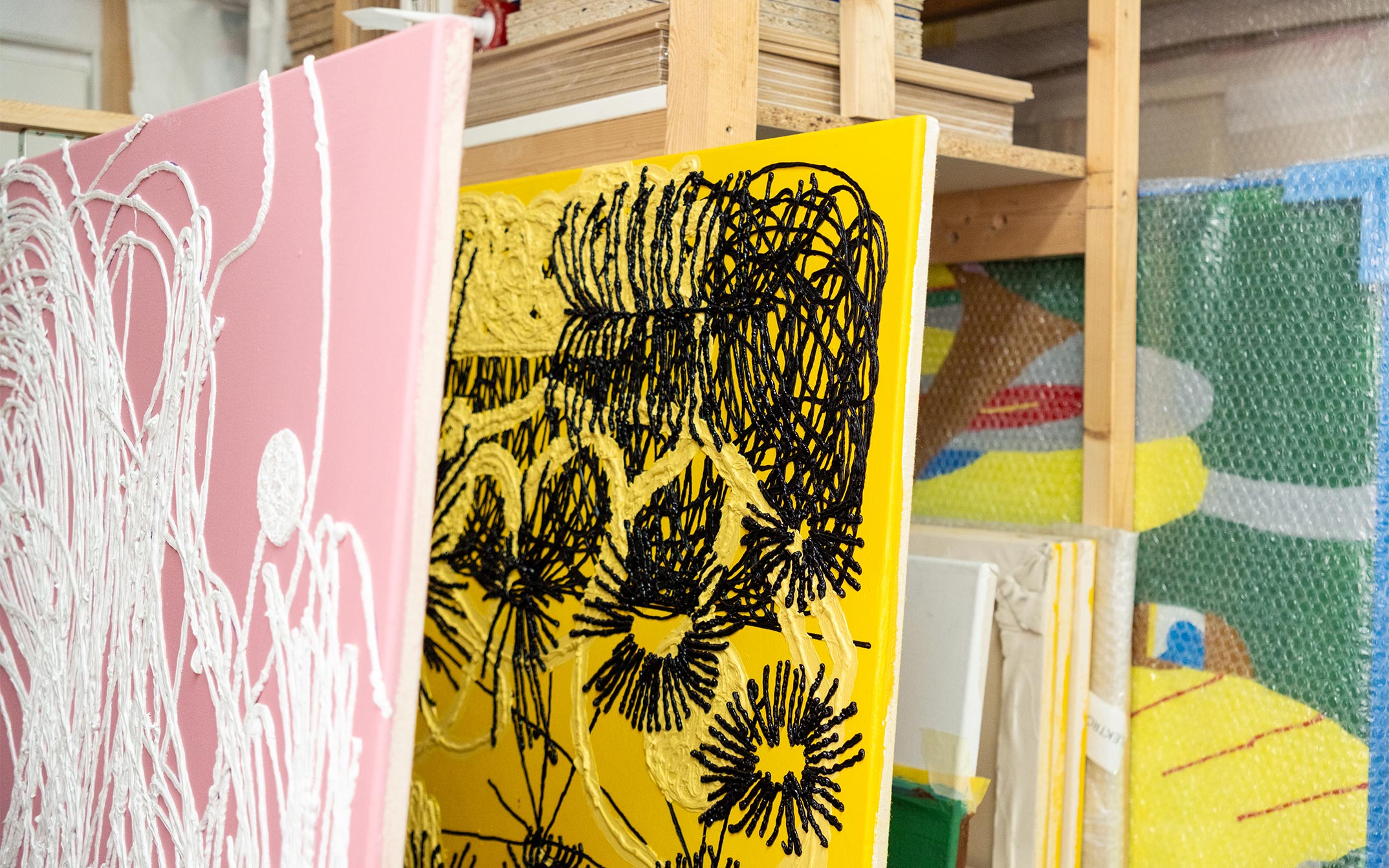
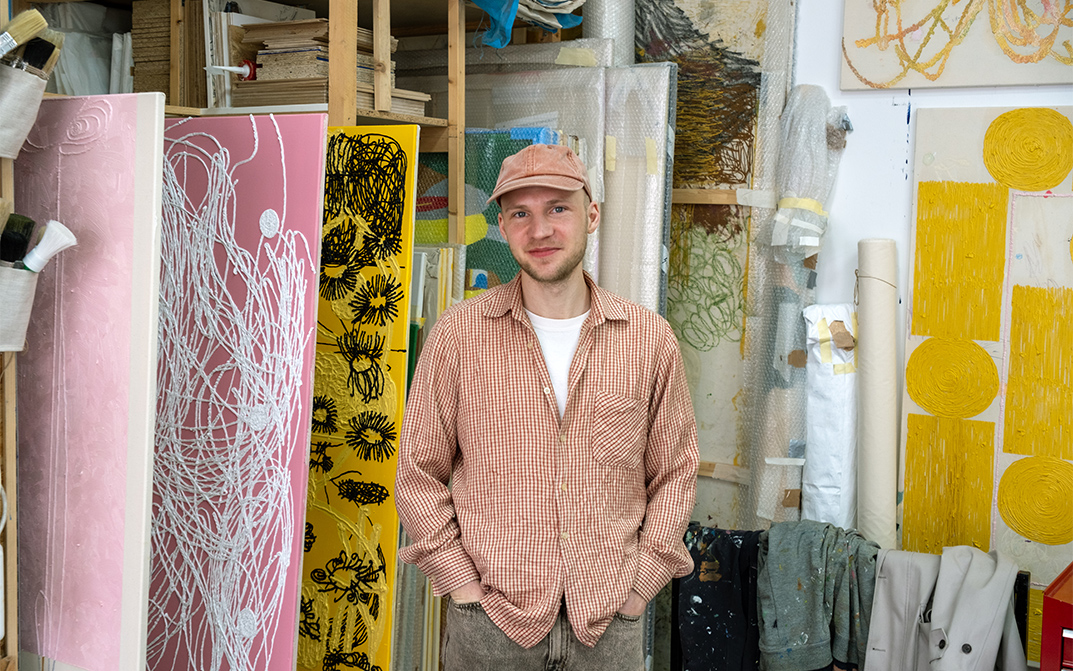
Is it sometimes annoying to be overwhelmed by so many impressions?
Yes and no. My studio here is quite a sensory overload: pictures, books, music, fabrics. At home, it is much quieter.
Where does this passion for collecting come from?
I have no idea! All these things are the backbone of my work but also companions in everyday life. Maybe it’s my way of bringing some order into his world. Engaging with the world of images is, in a way, also a way of ordering the world on a smaller scale.
What are you collecting?
I collect mainly books, fabrics, and lots of pictures. For instance, this old card with the Spice Girls, which you are looking at right now - it comes from a magazine, which I found on the street during a house clearing. And the fabric which you are sitting on right now comes from an old, abandoned church.
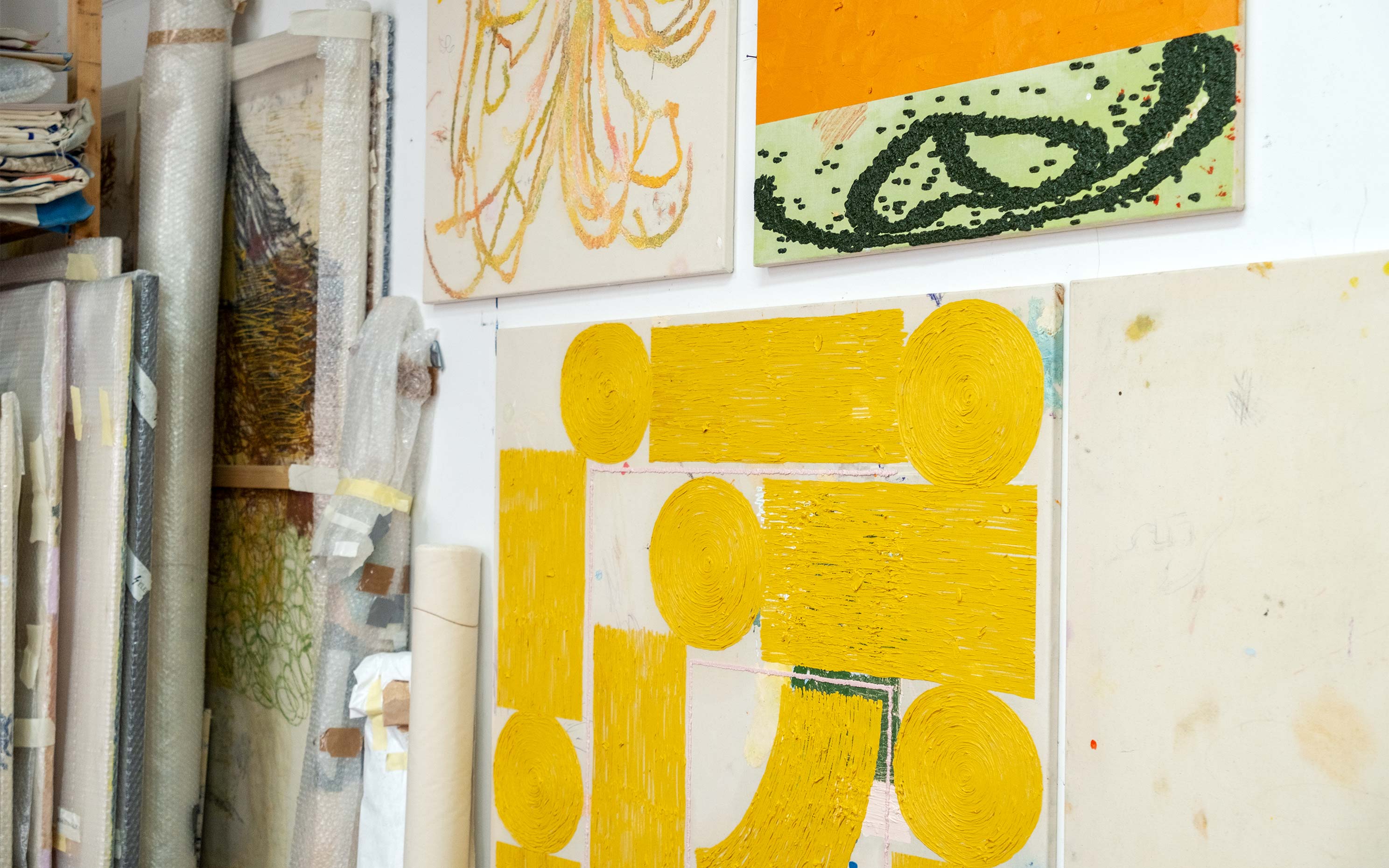
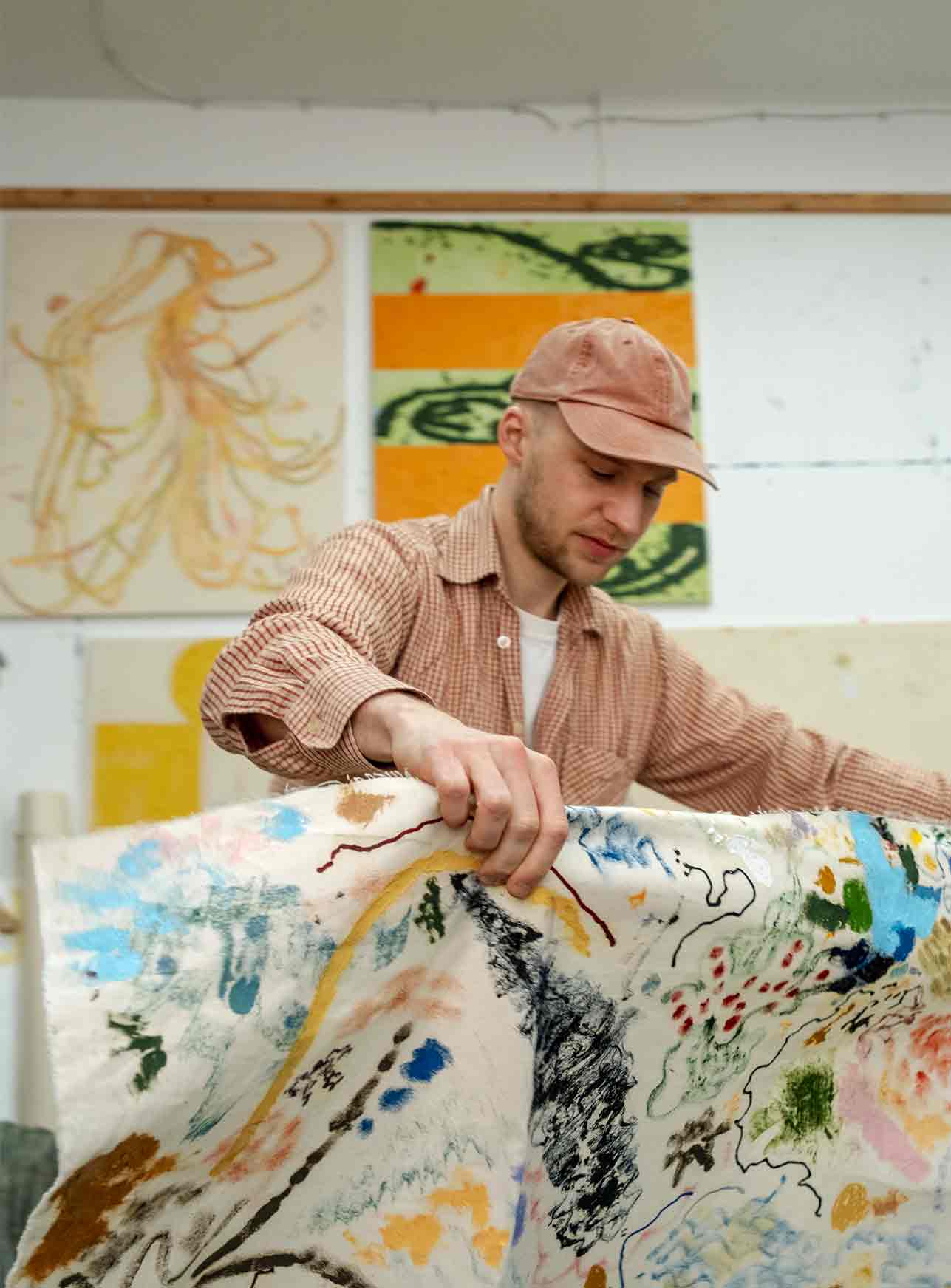
You do like things that have a history, right?
Absolutely! It’s like with the titles of my paintings or the ornaments I use: they are all cross references. With the smallest information, they allow you to travel somewhere else.
Speaking of ornament: in one of your books, I see a page with patterns which look similar to the ones of the style of Art Nouveau. Is this an art form that inspires you?
Yes. Because I grew up in Vienna, I probably cannot escape it. It’s like an imprint…
The ornament haunts you?
Yes, exactly (laughs). And then, you need to get rid of it.
In that blue picture on the opposite wall, I can see quite of bit of ornament though…
True - because I am fascinated by repetitions. This picture also holds many reliefs, because the oil paint is put on so densely.
Do your paintings always have titles?
Yes. If I can’t think of one, it would mean that the picture is not finished.
Your work is very attractive to the eye, some of it has a likeness to Hans Frank’s…
I get that sometimes, this connection to fabrics of Art Nouveau (laughs)!
Just not as “perfect”!
Right, because this is exactly as painting should be.
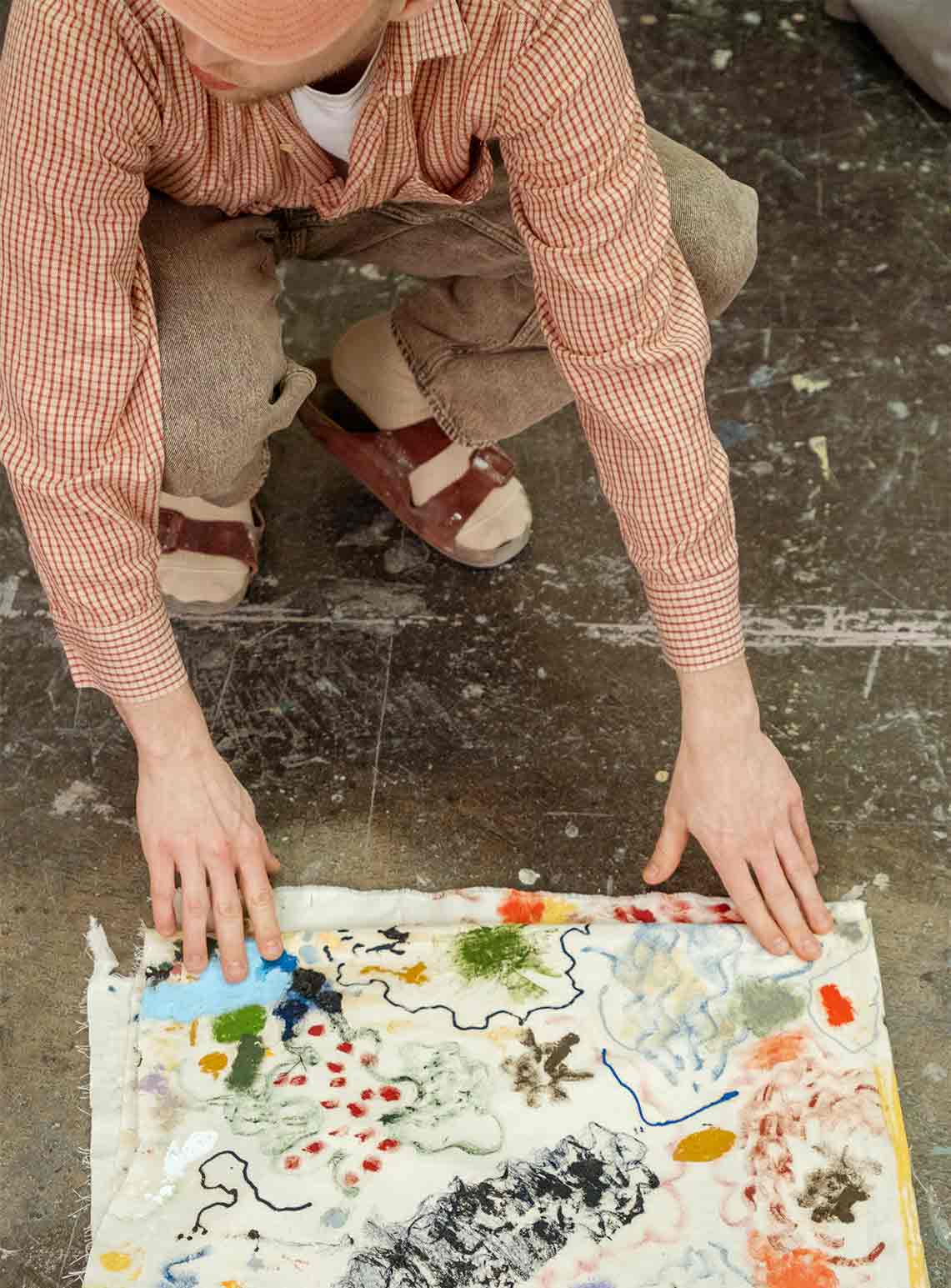
Speaking of Hans Frank and furniture - you have been working in cooperation with the furniture maker Freifrau, for which you painted fabrics by hand?
Yes, due to shortage of time, I was working directly on the already upholstered chairs. It was a challenge, but a beautiful cooperation. I had tried out different fabrics, how the colour acts on them. As a painter, one usually uses the classic primed canvas, but with some fabrics, the way they are woven or the colour sets is different, and I really love that.
This means you hand painted every chair?
Yes. And I allowed myself to dive into graphics, and to use my drawings one-to-one. In my paintings, this is translated quite differently. When viewed from a distance or online, it may appear as though all the forms share the same texture - even though they actually have completely different textures and details. The tactile quality is what makes painting so remarkable! The absolute opposite to the flat internet…
What do you think of working and living in Vienna?
It’s very relaxed! I grew up here but have been away for quite some time. The beautiful thing about Vienna is that it is of a timeless quality, there are so many things from the past. Sometimes time might even stand still, and this is pleasant.
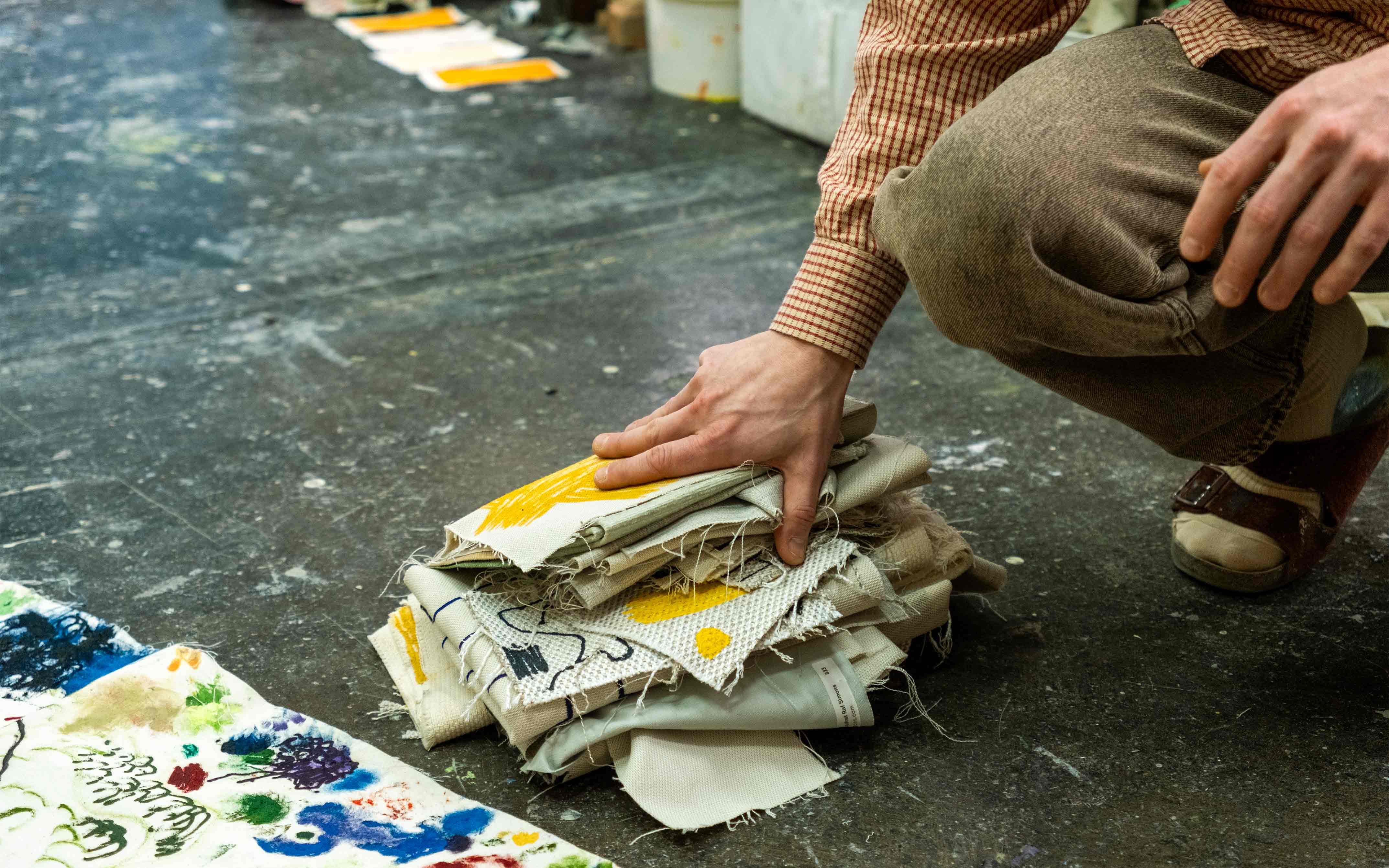
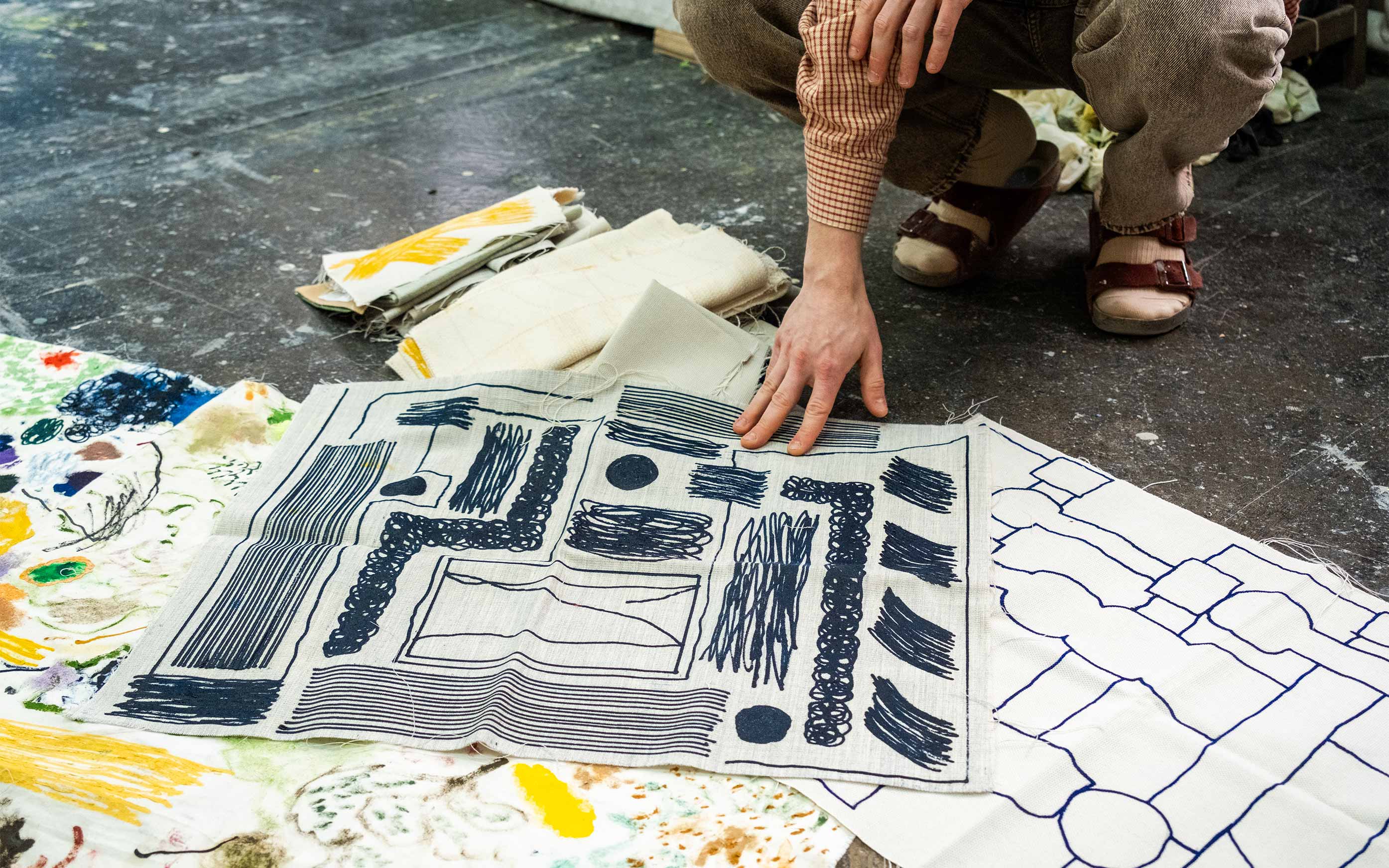
Interview: Alexandra Markl
Photos: Maximilian Pramatarov


